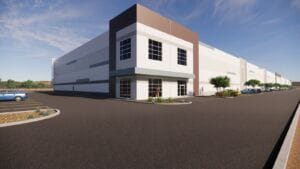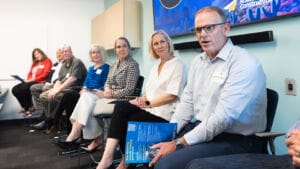Remember when grandparents used to consider nursing homes some kind of punishment akin to abandonment? There’s a good chance that reference has seen the last of its days. The senior living industry is seeing a huge transformation from “hospital mentality” to “hospitality.” Or, as one expert put it, developers are putting the “living” in “senior living.”
With the addition of more than 40 million seniors 65+ over the next 35 years, America will need to doubling its number of caregivers. Since that population isn’t growing as quickly, there will be more need for assisted living facilities.
“At the present time, neither the training programs nor the pay scales are ready to attract the workforce that will be needed,” says Paul Schoeffler, senior pre-construction manager at Adolfson & Peterson Construction. The Weitz Company has worked in the senior care market since the 1960s. Based on its research, the senior living trend is leaning “overwhelming” toward stand-alone assisted living, says Brendan Morrow, Weitz’s director of senior living.
“It seems to be what everyone is building,” he says. “The current market size is about 50,000 units for all services. We project that to grow to 180,000 by 2030. Between now and 2030, the population of people 65 and older is projected to grow by 257 percent.”
There are 76.4 million Americans who were born between 1946 and 1964 — the affectionately named Baby Boomer generation. The oldest Boomers are about 68 years old, points out Morrow. This means they’re 13 years younger than the average occupant of a senior care facility, he says. Currently, about 12 percent of individuals who are age and income qualified for senior care facilities are residents. With the projected growth of population, demand will increase. However, Morrow says there’s still “some time before that explosion starts.”
“The facilities that are being built are nicer, more luxurious with many amenities and people are more willing to leave their homes,” he says.
This is the generation that followed those who were hardened by WWII. For Jan Wiggins, sales director at assisted living facility Vi at Grayhawk, this means a generation of arrested
development. “
They’re buying the lifestyle [of an assisted living facility],” says Wiggins. “They’re spoiled already. They’re not like the people who are 90 and live here and went through the wars. They were
more thrifty. They saved. The people coming in now like the idea that somebody is always going to be taking care of them.” This is what Wiggins says gives a place like Vi at Grayhawk a competitive edge in the market — its large care center. Residents who buy into the lifestyle also buy into the care plan, which guarantees that they never have to leave the property or be, “farmed out,” she says, to another care facility.
“I question that about the new developments,” she says. “A large care center makes all the difference in the world.”
Adolfson & Peterson Construction’s Schoeffler has worked on multiple assisted living facilities and says healthcare integration begins on “day one” when planning a new development.
“Today’s new facilities need to include not only a robust special system infrastructure, but the flexibility to upgrade the infrastructure as the facility ages,” he says.
The level of caregiver services required in each type of assisted living area — memory care, skilled nursing, hospice — and how many rooms and how much space is dedicated to each assisted living type are “critical for plan development.”
“Many older facilities still focus on the aging aspect of assisted living rather than the living aspect of assisted living,” he says. “Caregiver training will be needed to change these attitudes.”
A CHOICE LIFESTYLE
Though Wiggins has observed that generations are staying independent longer, the average age of residents in Vi at Grayhawk’s community is dropped. Since January 2013, 72 homes have sold.
Many new residents are couples in their 70s, she says. However, she has seen some people as young as 59 join the community.
“Now it’s a choice, not an obligation,” she says.
Choices is the operative word, according to Schoeffler.
“Baby Boomer expectations are almost unlimited and always have been. I know because I am one,” says Schoeffler. “No sitting around for us after retirement. Many of us look to reinvent ourselves on a regular basis. We expect any place we live to offer all the services we have had for years — internet, TV, activities, fitness centers, yoga classes, dining options, outing options and choices — lots of choices.”
About one million Americans live among an estimated 30,000 senior care facilities, reports the Small Business Development Center Network. Assisted living facility industries are part of a $259B industry, according to data reported by healthcare research firm Kalorama
Information. Vi at Grayhawk, for instance, accepts outpatients and private pay patients from Mayo Clinic and Scottsdale Healthcare facilities to offset its fees.
The number of seniors are expected to double by 2030, but the caregiving generation
is not growing as quickly.The need is increasing, many elderly may be postponing
retirement due to housing market slumps.
Baby Boomers represent more than 70 percent of the country’s financial assets and more than half of discretionary spending, according to the SBDC.
BABY (BOOMER) STEPS
Healthcare real estate has been progressively moving toward a more campus-like environment. However, as Wiggins mentioned earlier, senior care facilities that can curb the need to outsource its patients have an advantage for securing residents.
Morrow cites Denver, Texas cities and others in the Midwest as hot spots for senior
living.
Arizona ranks in the top 10 states for rental assisted living, rental memory care, rental independent living and entry level fee CCRC. Another thing it has going for it is outdated facilities.
“A good sign for Arizona is we have a lot of aging facilities and a lot of investors looking to get their hands on those. Many of these facilities built in the ‘70s and ‘80s are now ready for a facelift,” he says, adding the weather and golf courses accessibility don’t hurt the state’s draw.
What can also draw more attention is technology — be it TeleMedicine suites, preventive monitoring systems or offering more memory care options.
“On the memory care side of things, there is a real need for facilities that can handle Alzheimer’s patients,” says Morrow. “As a country, the main focus has been on eliminating other diseases and less on the Alzheimer’s and dementia. As people live longer their likelihood of showing signs of these ailments increases substantially.”
The most notable trend, Morrow says, is “the change from a hospital mentality to a hospitality
mentality.”
“We have three product lines colliding: healthcare, housing and hospitality,” he says. “Some of the facilities are over-the-top nice, but the facility doesn’t have to do all the work. The concierge
service, room service, wellness coaches and things of that nature are taking senior care service to a new level. In the right facility, you can really get pampered physically and mentally. It’s not your old nursing home picture in your mind, that is for sure.”



